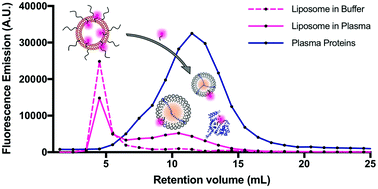Why Did The Liposomes Fluoresce During Size-exclusion Chromatography?
Dissociation of fluorescently labeled lipids from liposomes in biological environments challenges the estimation of uptake studies†
Author affiliations
Abstract
Within nanomedicine, liposomes are investigated for their power to deliver drug cargoes specifically into subcellular compartments of target cells. Such studies are often based on flow cytometry or microscopy, where researchers rely on fluorescently labeled lipids (FLLs) incorporated into the liposomal membrane to decide the localization of the liposomes within cells. These studies assume that the FLLs stay embedded in the liposomal membrane throughout the duration of the experiment. Here, nosotros used size exclusion chromatography (SEC) to investigate the validity of this supposition by quantitatively determining the propensity of various widely used FLLs to dissociate from liposomes during incubation in homo plasma. For sure commonly used off-the-shelf FLLs, upwards to 75% of the dye dissociated from the liposomes, while others dissociated less than 10%. To investigate the implications of this finding, we measured the peripheral blood leukocyte uptake of liposomes formulated with different FLLs using menstruum cytometry, and observed a significant difference in uptake correlating with the FLL's dissociation tendencies. Consequently, the choice of FLL can dramatically influence the conclusions fatigued from liposome uptake and localization studies due to uptake of dissociated FLLs. The varying dissociation propensities for the FLLs were not reflected when incubating in buffer, showing that non-biological environments are unsuitable to mimic liposomal stability in a drug delivery context. Overall, our findings suggest that it is crucial for researchers to evaluate the stability of their FLL-labeled liposomes in biological environments, and the simplicity of the SEC assay put forward here makes it very applicable for the purpose.

Y'all have access to this commodity
 Delight wait while nosotros load your content... Something went wrong. Try once more?
Delight wait while nosotros load your content... Something went wrong. Try once more?
Supplementary files
- Supplementary information PDF (19115K)
Commodity information
- DOI
- https://doi.org/ten.1039/C8NR07755J
- Commodity type
- Communication
- Submitted
- 24 Sep 2018
- Accepted
- twenty Nov 2018
- First published
- 21 Nov 2018
Nanoscale , 2018, ten, 22720-22724
Social activeness
Spotlight
Advertisements
Why Did The Liposomes Fluoresce During Size-exclusion Chromatography?,
Source: https://pubs.rsc.org/en/content/articlelanding/2018/nr/c8nr07755j
Posted by: millerdidettioners.blogspot.com


0 Response to "Why Did The Liposomes Fluoresce During Size-exclusion Chromatography?"
Post a Comment